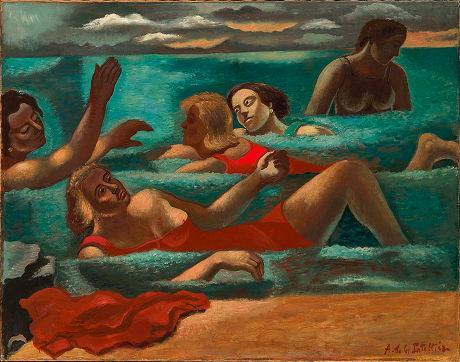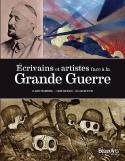Art Of The Day Weekly
#350 - from 12 June 2014 to 18 June 2014

Amédée de la Patellière, Bathers at Bandol, 1928, oil on canvas, 114,2 x 145,8 cm. Beauvais, Musée départemental de l’Oise. © RMN-Grand Palais / Adrien Didierjean
IN THE AIR
La Patellière, pulled out from the 1920s
ROUBAIX – His last major exhibition dates back to 1945. Amédée de La Patellière (1890-1932) had a nephew, Denys, known for his movie Un taxi pour Tobrouk. But Amédée, a painter, has been almost totally forgotten. Yet there was a period, right between the two wars, when he was quite well-known, in particular due to the support of gallery owner Katia Granoff, one of the most dynamic at the time. His generation was pushed into adult life as World War I broke out, and he was mobilised from 1914 to 1918. His career was cut short by his early demise at the age of 42. He integrated various influences, at times Cubist with touches of Derain, or Art déco with a proximity to Tamara de Lempicka. La Patellière alternated bright paintings and dark periods in the style of la Permeke, hence the difficulty to define him or place him in one given movement. The exhibition, of some 150 works, among them his drawings when he was at combat, his Baigneuses and his intimate scenes, should help put the artist back on the map of modern art.
• Amédée de La Patellière, les éclats de l’ombre at la Piscine, from 14 June to 14 September 2014.
EXHIBITIONS
Shakespeare, a fashionista?
MOULINS – There exists a Shakespeare fashion, Shakespeare collections and true fashion addicts since the death of the bard of Stratford-upon-Avon four centuries ago. Here we refer of course to the numerous stage costumes that his plays gave birth to. It would be impossible to list them all, and this exhibition focuses on one single aspect, the French one. First we have the necessary re-creation of an Elizabethan theatre with a circular stage that advances in the middle of the audience. It is followed by a long gallery of tempting materials, from the Petruccio costume in The Taming of the Shrew, given in 1891 at the Comédie-Française, to the floating tunics designed by Yannis Kokkos for Mid-Summer Night’s Dream in 2002 at the Amandiers in Nanterre. Various creators met the challenge, such as Léon Gischia who in 1947 designed Jean Vilar’s costume for the unforgettable Richard II at the first festival of Avignon; Mario Prassinos and Thierry Mugler as well. This wide range underlines Shakespeare’s universality. Lady Macbeth and Hamlet can slip into a crinoline as well as adapt to the punk aesthetics.
• Shakespeare, l’étoffe du monde at the Centre national du costume de scène, from 14 June 2014 to 4 January 2015.
Sorolla at the beach
BARCELONA – He is the major Spanish Impressionist painter, and his rating has constantly gone up these last few years. He is a true star in Madrid, where his sumptuous home-workshop can be visited. But Joaquín Sorolla (1863-1923) was a native from Valencia. We can thus understand the importance of the sea in his inspiration.
• Sorolla, el color del mar at Caixa Forum, from 12 June to 14 September 2014.
Willette, a Jack of all trades
L’ISLE-ADAM – This week we have another interesting rediscovery, that of Adolphe Willette (1857-1926). He is known as a press cartoonist (for Le Chat noir or L’Assiette au beurre) capable of large painted compositions, ironic allegories on progress or the wrongdoings of love. He was very versatile, he intervened in the decors of the Hôtel de Ville in Paris –Town Hall-, designed hand fans, signs for embroidery shops, ads for the Van Houten cacao, and many more.
• Adolphe Willette at the musée d’Art et d’Histoire Louis-Senlecq, from 15 June to 28 September 2014.
The secrets of colour
LONDON – From the expensive lapis-lazuli sent from distant Afghanistan or the pastel cultivated in the fields near Toulouse, these are but a few of the raw materials that helped artists in the past to produce colour. The market they represented was huge: at the end of the XVIIth century the cochineal was the first export from Mexico. The exhibition goes lightly on the technical aspect by dedicating a room to each colour: yellow is organized around Van Dyck, red welcomes Masaccio and La Coiffure by Degas.
• Making Colour at the National Gallery, from 18 June to 7 September 2014.
AUCTIONS

Lot 401, Bosc (1924-1973), Bird on the cross, Indian ink on Arches paper, signed at bottom right 38.5 x 32 cm. Estimate: €1200-€1500.
After comic strips, will we auction cartoons?
PARIS – The prices of comics are soaring, as we can see in the recent record of a sheet by Hergé, sold at €2. 65 million on 24 May at Artcurial. It would only be fair that cartoons follow the same path. Why, if we take the example of France, is a work by Reiser or by Copi ten or one hundred times less expensive than one by Bilal? This auction will show us if anything is being corrected, to contradict the very reasonable estimates, at a few hundred Euros. Aside from a few living figures such as Sempé, Siné or Pajak, the leaders are the major seniors, such as Reiser (1941-83) and Copi (1939-87). But there is also Dubout (1905-1976), Bosc (1924-73) or Chaval (1915-68), the author of Les oiseaux sont des cons (Birds are idiots). His end was as tragic as his cartoons were ironic. His wife committed suicide when he told her he had cheated on her. He followed in her footsteps shortly after, by opening the gas in the apartment but leaving a note on the front door, just in case, “Danger of explosion”.
• Dessins d’humour, collection Dominique Charnay on 16 June 2014 at hôtel Drouot (Cornette de Saint-Cyr)
ARTIST OF THE WEEK
Hirschorn, a socially oriented mind
How can one give sense to art? How can a work of art keep a social value, but not only aesthetic or financial? Thomas Hirschhorn, born in 1957, answered this question through installations that are often monumental, to which the public is invited to walk, sit and discuss. The latest one, at the palais de Tokyo, which combines packaged furniture, old tires, graffiti and banners from demonstrations, resembles a squat by anti-globalisation militants. One does not only look. Every day there are debates - with more than one hundred debaters on the agenda – on the excesses of globalisation, the sense of reading in a digital society, the future of teaching, of poetry, of Europe. This will be a sort of assessment on the sense of life, which will be summarised every day for two months in a small diary.
• Thomas Hirschhorn, Flamme éternelle at Palais de Tokyo, until 23 June 2014.
OPENINGS OF THE WEEK
BOOKS
World War I, a matter of artists
'I hate the XXth century as I hate rotten Europe': writer Georges Duhamel wrote in 1917 in Civilisation, when he was a surgeon on the line of combat. As for Fernand Léger, then a porter, when a friend asked him if he would remain a Cubist after the conflict, he said with strenght: 'There is no greater Cubism than a war such as this one that divides a man more or less properly in various pieces and sends them to the four corners of the eartht.' As is shown in this well illustrated work, presented as a chronological diary of the four years of hell, artists, writers and musicians also suffered during this conflict. While some managed to hide, such as Duchamp, Raimu or Delaunay, refugied in Spain, many paid a high price, the dead above all - Boccioni, Franz Marc, Gaudier-Brzeska, Louis Pergaud -; but also the seriously wounded such as Apollinaire, Braque or Jean Renoir. Even when one is far from the shots of fire, one can die from them. Animal sculptor Rembrandt Bugatti, depressed and sick, committed suicide when he learned the lions from the zoo of Antwerp had become dangerous from hunger and had to be shot.
• Ecrivains et artistes face à la Grande Guerre, by Claude Pommereau, Claire Maingon, Guillaume Picon, Beaux Arts éditions, 2014, 280 p., €39.50.

